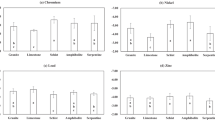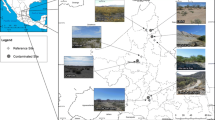Summary
The aim of this study was to provide data to evaluate the short- and long-term effects of heavy metals on arylsulphatase activity in five soils. The effects are fitted on a logistic dose-response model and are presented graphically as the ecological dose (heavy metal concentration corresponding to 50% inhibition; ED50) and ecological dose range (heavy metal concentration range corresponding to 10–90% inhibition; EDR). In 7 out of 22 comparable soil-metal combinations the ED50 decreased significantly over 6 weeks to 18 months of incubation and in two cases the ED50 increased. Toxicity (defined as ED50) was highest in sand and sandy loam and lowest in sandy peat. Cd toxicity in sand, silty loam, and clay varied from 1.08 to 9.04 mmol kg-1. Both Cr and Ni toxicity varied strongly and decreased with time in some soils while increasing in others. The Cu toxicity ranged from 4.51 to 2 mmol kg-1 in sand and silty loam, respectively, but remained fairly constant over time. Pb was the least toxic element (14.5 to 59.9 mmol kg-1). The toxicity of Zn ranged from 5.73 to 148 mmol kg-1 in sand and sandy peat, respectively. At critical concentrations set by the Dutch Soil Protection Act, Cr, Cu, Ni, and Zn inhibited arylsulphatase by 53, 35, 48 and 97%, respectively.
Similar content being viewed by others
References
Al-Khafaji AA, Tabatabai MA (1979) Effects of trace elements on arylsulphatase activity in soils. Soil Sci 127:129–133
Alvey N, Galwey N, Lane P (1982) An introduction to GENSTAT. Academic Press, London
Babich H, Bewley RJE, Stotzky G (1983) Application of “Ecological Dose” concept to the impact of heavy metals in some microbe-mediated ecological processes in soil. Arch Environ Contam Toxicol 12:421–426
Burns RG (1978) Enzyme activity in soils: some theoretical and practical considerations. In: Burns RH (ed) Soil enzymes. Academic Press, London, pp 51–96
Burns RG (1982) Enzyme activity in soil: Location and a possible role in microbial ecology. Soil Biol Biochem 14:423–427
Chaney WR, Kelly JM, Strickland RC (1978) Influence of cadmium and zinc on carbon dioxide evolution from litter and soil from a black forest. J Environ Qual 7:115–119
Doelman P, Haanstra L (1984) Short-term and long-term effects of cadmium, chromium, copper, nickel, lead, and zinc on microbial respiration in relation to abiotic soil factors. Plant and Soil 79:317–327
Doelman P, Haanstra L (1986) Short- and long-term effects of heavy metals on urease activity in soils. Biol Fertil Soils 2:213–218
Doelman P, Haanstra L (1989) Short- and long-term effects of heavy metals on phosphatase activity in soils: An ecological dose-response model approach. Biol Fertil Soils 8:235–242
Haanstra L, Qude Voshaar JH, Doelman P (1985) The use of sigmoidal dose response curves in soil ecotoxicological research. Plant and Soil 84:293–297
Han KW, Yoshida T (1982) Sulfur mineralisation in rhizosphere of lowland rice. Soil Sci Plant Nutr 28:379–387
Jarvis BW, Lang GE, Wieder RK (1987) Arylsulphatase activity in peat exposed to acid precipitation. Soil Biol Biochem 19:107–109
Juma NG, Tabatabai MA (1977) Effects of trace elements on phosphatase activity and physico-chemical properties in woodland soils. Soil Biol Biochem 15:93–99
Mathé P, Kovacs G (1980) Effect of Mn and Zn on the activity of phosphates in soil: I. Phosphatase activity of a calcareous chernozem soil under maize. Agrokemi Talajtan 29:441–446
Mathur SP, Sanderson RB (1980) The partial inactivation of degradative soil enzymes by residual fertilizer copper in histosoils. Soil Sci Soc Am J 44:750–755
Nannipieri P (1984) Microbial biomass and activity measurement in soil. Ecological significance. In: Klug MJ, Reddy A (eds) Perspectives in microbial Ecology. Am Soc Microbiol, Washington DC, pp 515–521
Nordgren A, Bååth E, Söderström B (1983) Microfungi and microbial activity along a heavy metal gradient. Appl Environ Microbiol 45:1829–1837
Nriagu JO, Soon YK (1984) Arylsulphatase activity in polluted lake sediments. Environ Pollut (Ser 8) 8:143–153
Perucci P, Scarponi L (1984) Arylsulphatase activity in soils amended with crop residues: kinetic and thermodynamic parameters. Soil Biol Biochem 16:605–608
Premi PR, Cornfield AH (1969) Effects of addition of copper, manganese, zinc, and chromium compounds on ammonification and nitrification during incubation of soil. Plant and Soil 31:345–352
Press MC, Henderson J, Lee JA (1985) Arylsulphatase activity in peat in relation to acidic deposition. Soil Biol Biochem 17:99–103
Pugh GJE, Williams JI (1971) Effect of an organo-mercury fungicide on saprophytic fungi and on litter decomposition. Trans Br Mycol Soc 57:164–166
Reber HH (1989) Threshold levels of cadmium for soil respiration and growth of spring wheat (Triticum aestivum) and difficulties with their determination. Biol Fertil Soils 7:152–157
Rother JA, Millbank JW, Thornton I (1982) Seasonal fluctuations in nitrogen fixation (acetylene reduction) by free living bacteria in soils contaminated with cadmiun, lead, and zinc. J Soil Sci 33:101–113
Rühling A, Tyler P (1973) Heavy metal pollution and decomposition on spruce needle litter. Oikos 24:402–416
Sarathchandra SU, Perrott KW (1981) Determination of phosphatasè and arylsulphatase activities in soils. Soil Biol Biochem 13:543–545
Tabatabai MA (1977) Effects of trace elements on urease activity in soils. Soil Biol Biochem 9:9–13
Tabatabai MA, Bremner JM (1970) Arylsulphatase activity in soils. Soil Sci Soc Am Proc 34:225–229
Tabatabai MA, Bremner JM (1971) Michaelis constants of soil enzymes. Soil Biol Biochem 3:317–323
Tyler G (1976) Heavy metal pollution, phosphatase activity and mineralization of organic phosphorus in forest soils. Soil Biol Biochem 8:327–332
Walter C, Stadelmann (1979) Influence du zinc et du cadmium sur les microorganisms ainsi que sur quelques processus biochimiques du sol. Schweiz Landwirtsch Forsch 18:311–324
Author information
Authors and Affiliations
Rights and permissions
About this article
Cite this article
Haanstra, L., Doelman, P. An ecological dose-response model approach to short- and long-term effects of heavy metals on arylsulphatase activity in soil. Biol Fertil Soils 11, 18–23 (1991). https://doi.org/10.1007/BF00335828
Received:
Issue Date:
DOI: https://doi.org/10.1007/BF00335828




